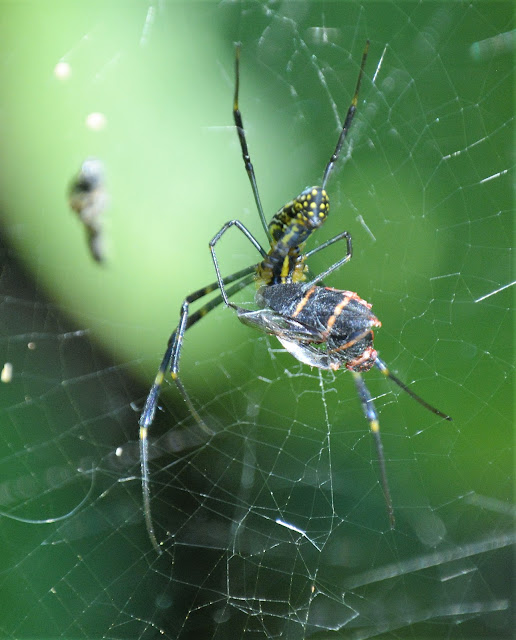Joro Spider Update: controlling this invasive species
Joro spiders are EVERYWHERE! If you live in North Georgia you are bound to run into one of their webs as soon as you step outside. Removing their webs from our patio area, walking paths and amongst the shrubs is a daily chore. Their webs are strong and multi paneled and can be found from the shrub layer to high up in the tree canopy. The three layered web has one central orb with two asymmetrical layers on either side. The sticky silk captures all manner of insects and are strong enough to catch hummingbirds, small bats, tree frogs or lizards.
We found the first Joro spiders in our garden four years ago. You can read my post about their discovery here. These spiders are a non-native species [from Asia] that have multiplied astronomically since they landed on our shores. They spread rapidly because they travel easily using a ballooning method where they catch wind currents with a strand of their silk. In just eight years, they have spread to at least 23 counties in Georgia.
 |
| Male & Female Joro Spider |
They are not [yet] officially classified as invasive since studies are currently underway to scientifically determine their impact on the local environment. But we know that many introduced species impact the native species and will upset the balance of the local ecosystem.
Generally, we view spiders as beneficial and welcome them in our garden. Just like other predator species, spiders serve an important role in the ecosystem, controlling insect populations. They also serve a vital link in the food web as a crucial protein source for birds, lizards, wasps and even other spiders. So what is the problem with Joro spiders?
 |
| Female Joro spider with European honeybee |
They do make an impact on insect populations, especially those that most people view as pests. In fact, they will prey on another non-native insect, the brown marmorated stink bug, that our native spiders won't touch. The Joro spider can also be food for mud daubers and other wasps.
 |
| female Joro spider capturing a two lined spittle bug |
The issue is that they are competing with our native garden spider and other spiders in the orb weaver family for food. Sadly, this year we haven't found any yellow garden spiders (Argiope aurantia) on our property. Is this because of the introduction of the Joro spider? Scientific studies will provide more data in the coming years but my anecdotal observations say yes.
 |
| Joro spider seizing a Eastern Tiger Swallowtail butterfly |
These non-native spiders are feeding on our native insects, and with the Joro spider's large numbers, it appears they will further reduce our native insect population, which is already in peril. I'm a believer in letting nature maintain a balanced ecosystem in the garden, leaving predaceous insects and insectivorous vertebrates to provide environmental regulation. However, when a non-native species is introduced, this can wreak havoc on the biome.
So we are intervening by removing the Joro spider webs that are reachable with a broom or stick. When possible, we also kill the spiders by stomping on them. But be prepared as they move quickly and when you take down a web containing multiple spiders you need to act quickly. Early September is when these spiders reach maturity and will die by late November, but not before leaving egg sacs filled with 400-1500 eggs that will hatch next year. If you find an egg sac and are able to positively identify it as one from a Joro spider and not a native spider, it can be destroyed. Our efforts may only make a small impact on their numbers, but hopefully we are saving many pollinators and other native insects from being captured.

.png)